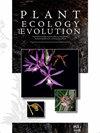蜜蜂增加了野生植物的种子数量,而可耕地的比例对欧洲农业景观的授粉有不同的影响
IF 1.1
4区 生物学
Q3 PLANT SCIENCES
引用次数: 7
摘要
背景和目的-农业集约化和农田异质性的丧失导致了野生蜜蜂和其他传粉媒介种群的减少,这可能导致随后昆虫传粉的野生植物数量减少。材料和方法:利用来自欧洲22种依赖传粉媒介的野生植物的37项研究数据,我们调查了昆虫传粉植物的访花率和种子集是否随着1公里范围内可耕地比例的增加而下降。主要结果:结实率随着蜜蜂访花次数的增加而增加,其中大部分是野生蜜蜂,但与其他昆虫访花次数的增加无关。不同研究中,耕地比例的增加对蜜蜂的坐果和访花有很强的影响。结论:景观配置、当地生境质量和资源可用性的暂时变化(例如,由于大量开花的作物或蜂箱)等因素可能会改变耕地对授粉的影响。虽然我们的研究结果强调了野生蜜蜂的持续存在对维持植物多样性至关重要,但我们也表明,在同质化的农业景观中,蜜蜂种群数量下降导致的花粉限制并不是导致蜜蜂和昆虫授粉植物平行损失的普遍驱动因素。本文章由计算机程序翻译,如有差异,请以英文原文为准。
Bees increase seed set of wild plants while the proportion of arable land has a variable effect on pollination in European agricultural landscapes
Background and aims – Agricultural intensification and loss of farmland heterogeneity have contributed to population declines of wild bees and other pollinators, which may have caused subsequent declines in insect-pollinated wild plants. Material and methods – Using data from 37 studies on 22 pollinator-dependent wild plant species across Europe, we investigated whether flower visitation and seed set of insect-pollinated plants decline with an increasing proportion of arable land within 1 km. Key results – Seed set increased with increasing flower visitation by bees, most of which were wild bees, but not with increasing flower visitation by other insects. Increasing proportion of arable land had a strongly variable effect on seed set and flower visitation by bees across studies. Conclusion – Factors such as landscape configuration, local habitat quality, and temporally changing resource availability (e.g. due to mass-flowering crops or honey bee hives) could have modified the effect of arable land on pollination. While our results highlight that the persistence of wild bees is crucial to maintain plant diversity, we also show that pollen limitation due to declining bee populations in homogenized agricultural landscapes is not a universal driver causing parallel losses of bees and insect-pollinated plants.
求助全文
通过发布文献求助,成功后即可免费获取论文全文。
去求助
来源期刊

Plant Ecology and Evolution
PLANT SCIENCES-
CiteScore
2.20
自引率
9.10%
发文量
27
审稿时长
>12 weeks
期刊介绍:
Plant Ecology and Evolution is an international peer-reviewed journal devoted to ecology, phylogenetics and systematics of all ‘plant’ groups in the traditional sense (including algae, cyanobacteria, fungi, myxomycetes), also covering related fields.
The journal is published by Meise Botanic Garden and the Royal Botanical Society of Belgium.
 求助内容:
求助内容: 应助结果提醒方式:
应助结果提醒方式:


